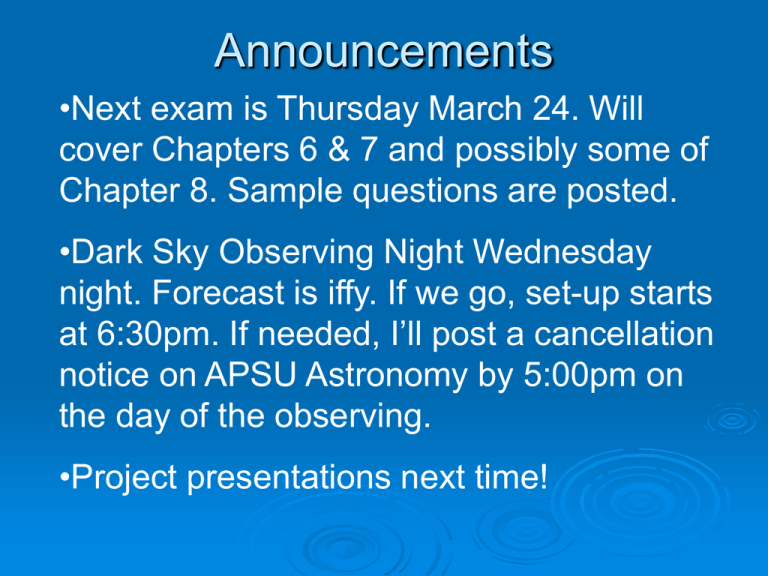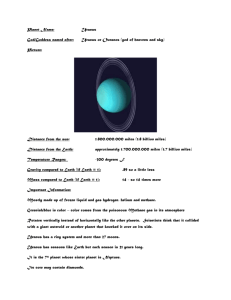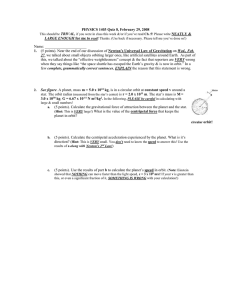Announcements
advertisement

Announcements •Next exam is Thursday March 24. Will cover Chapters 6 & 7 and possibly some of Chapter 8. Sample questions are posted. •Dark Sky Observing Night Wednesday night. Forecast is iffy. If we go, set-up starts at 6:30pm. If needed, I’ll post a cancellation notice on APSU Astronomy by 5:00pm on the day of the observing. •Project presentations next time! Chaos in the Solar System At its very inception, Newton knew that it would be impossible to get a “closed solution” to the three body problem The orbits of all the planets are known to have long-term variations The biggest problems were with the orbits of Jupiter and Saturn Their interactions led to periodic variations and what appeared to be non-periodic changes Lagrange and Laplace showed the seemingly non-periodic variations were, in fact, periodic Lagrange Laplace Laplace eventually forms a theory for why the solar system is as it is Laplace’s Traite de mecanique celeste becomes the standard of celestial mechanics The “missing planets” problem a 0.4 0.3 2m where m , 0,1, 2,3, 4,... The Titus-Bode Law predicted a planet between Mars and Jupiter. At the time, Uranus and Neptune had not been discovered On March 13, 1781 William Herschel discovered Uranus Its’ orbit matched the Titus-Bode Law Baron Franz Xaver von Zach quickly forms the “Celestial Police” to hunt down the missing planet between Mars and Jupiter Purely by chance, Giuseppi Piazzi discovers the “missing planet” on January 1, 1801. He names it Ceres Ceres is “lost” for a while but Carl Friedrich Gauss, at the Berlin Observatory, calculates an orbit and refinds it Within a year Heinrich Olbers discovers another body he names Pallas By 1807, two more objects, Juno and Vesta are discovered Juno Vesta Olbers thought all the asteroids originated from a single “exploded” planet but orbital calculations proved otherwise By 1850 over a dozen objects had been discovered By using pre-discovery observations of Uranus, Bode calculates an orbit for Uranus Urbain La Verrier uses perturbation theory to predict another planet The orbit of Uranus isn’t quite what it should be if you figure the influence of Jupiter and Saturn At the same time John Couch Adams is making the same prediction Adams showed his calculations to James Challis, the director of the Cambridge Observatory. He is unimpressed but relays the information to George Airy, the Astronomer Royal, who makes a half-hearted attempt to find it Eventually, an assistant of Gauss’ at the Berlin observatory, Johann Galle, locates the object: Neptune The next problem to be attacked was the orbit of Mercury The perihelion of the orbit of Mercury was known to precess. When all perturbations are figured in there still 43 arcseconds per century too much. Many searched for Vulcan but it was never found It turns out to be Newtonian mechanics that is error. Albert Einstein comes up with a new formulation of gravity: General Relativity. It exactly describes the orbit of Mercury The birth of Stellar Astronomy Prior to 1600 Stellar astronomy was just position and brightness Johann Bayer 1603 Uranometria Tycho’s Celestial Globe In 1572 Tycho observed a supernova so the stars weren’t always constant In 1603 Kepler observed another supernova In 1605 he publishes De Stella Nova on the new star and other celestial “events” The Chinese had observed supernova long before the Europeans The Chinese observed a supernova in 1054 that becomes the Crab Nebula In 1596 a Frisian, David Fabricius, notices a “nova” in Cetus In 1638 another Frisian, Johannes Holwarda observes another “nova” in the same place By 1622 Johannes Hevelius figures it out He didn’t know why but he figured out that the two novas were actually a single variable star Ismael Boulliau proposed a star spot explanation for stellar variability


